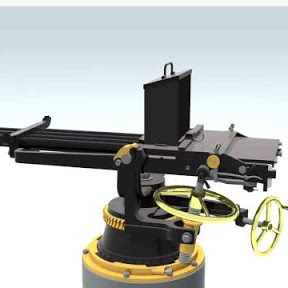The third part of an animation of the Holland Class submarines 1902 – 1913 in the Royal Navy. This part looks a how the boat was dived, controlled while underwater and surfaced. It may help to read these notes to follow the actions. If you like it – buy me a coffee (or tea)
buymeacoffee.com/vbbsmyt
An air compressor and ballast pump are installed on the Port rear of the petrol (gasoline) engine. A spur shaft is geared off the propeller shaft so that either the compressor or the ballast pump can be connected through a dog clutch.
To prepare for diving
The engine is stopped, and the lid of the exhaust box is screwed down tight to prevent water from entering the exhaust piping and, crucially, to prevent water from entering the cylinder heads of the engine. If this did happen, the incompressible water would, at best, stop the engine from turning over, or at worst crack the cylinder head. Either way the engine would be unusable.
The electric motor is started. This is a shunt wound motor, so a series of resistors are connected in series with the armature to limit the starting current. These resistors are disconnected as the motor gets up to speed.
It would be advisable to connect the ballast pump to the auxiliary machinery drive at this point. You never know when it might be needed.
The 10 inch ventilation fan is stopped and the internal and external hatches are shut and screwed down. This ventilator is used to extract fumes from the submarine engine, especially any petrol fumes.
The three ventilation poles are lowered. A flap valve automatically shuts the pole openings.
The depth gauge is vented. A screw valve is opened to allow any air that has got into the depth mechanism to escape. The Hollands have a draught gauge glass that is opened up. The water level in the gauge glass shows the keel depth (draught) of the submarine before it dives. This is important since if the boat is deeper than the optimum, it indicates that the boat is too heavy or if higher then it could be difficult to submerge. Adjustments to the submarine compensating tank content would them be made. The depth gauge pointer is then adjusted to indicate the correct draught.
The internal main ballast tank surrounds the bilge, and the forward battery compartment. It is fitted with a vent valve at the top and a Kingston valve at the bottom. A Kingston valve is a design where sea pressure tends to keep the valve shut.
To Dive.
The two air vent valves are opened, then the two Kingston valves allowing water into the ballast tank. The air in the tank is forced out through the vent valves into the atmosphere (not into the boat). When the ballast tank is full, both the vent valves and the kingston valve are left open.
When the ballast tank is full, the submarine still has a small amount of buoyancy. The Horizontal rudders at the stern are angled so the bow of the boat points downwards (at about 5-6 degrees) and the propeller drives the boat down.
Controlling the boat while dived.
The submarine depth can be controlled by using the horizontal planes to point the bows up or down. However, if the submarine is too light (too buoyant) it will need a continuous bow down attitude. If too heavy it will require bow up angle. This could cause problems with the periscope field of view, either pointing to the sky or into the waves.
If too light, more water can be flooded into the buoyancy tank, which is situated in the centre of the submarine. A hand operated Kingston valve allows water into this tank when necessary. If too heavy, the buoyancy tank, or any other water tank, can be pumped out using the ballast pump.
Once nearly neutral buoyancy has been achieved, the balance, or trim, of the submarine can be adjusted. If the bow of the submarine is too heavy relative to the stern, the bow will tend to drop. Trim tanks are fitted in the bow and stern to correct this imbalance. A special pair of linked valves are provided. Operating it in one direction opens up 50 psi air to one tank, for example the forward trim tank, and at the same time opens a water valve to allow water to be blown from forward tank to the aft.
Surfacing
The Holland submarine would normally surface by being planed up to the surface, so that the conning tower is awash. The two ballast tank air valves are then shut, and 10 psi air fed into the top of the tank to blow the water out through the kingston valves. When the tank is empty, the kingston valves are shut.
The tanks, however, cannot be blown with the 10psi air feed if the keel is below about 12 feet. Any deeper, then the hydrostatic pressure will exceed the air pressure. If it is necessary to surface in an emergency, a 50 psi supply can be used (down to about 80ft).
It is likely that one of the air ventilation tubes will be raised to equalise the pressure in the hull before the conning tower hatch is opened (don’t want to be blown out of the hatch).
Start the petrol engine and head for home.
Another successful cruise.

Hi, I’m Rob, otherwise known as VBBSMYT.
I create the animations on my iMac using Cinema 4D, which I find very intuitive, and allows me to add smoke and flames, and then send the model to my trusty Render farm.
I make my models as accurate as possible through reference books and particularly good drawings. You may have seen my animations of early torpedoes and machine guns on YouTube. I enjoy finding out how things work and it has been fascinating to track the development from the late Victorian period up to World War 1.





